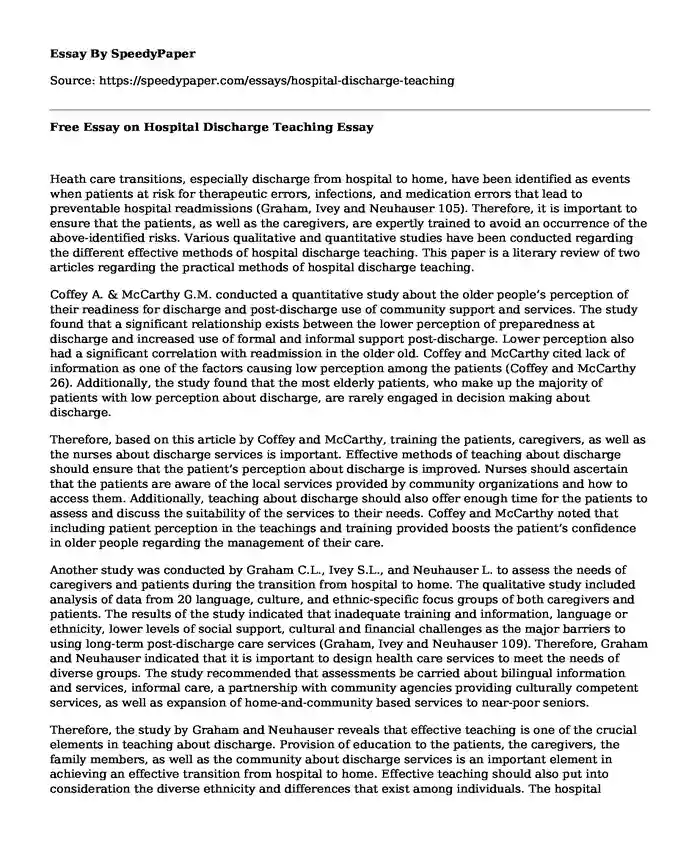
| Type of paper: | Essay |
| Categories: | Education Health and Social Care Medicine |
| Pages: | 3 |
| Wordcount: | 643 words |
Heath care transitions, especially discharge from hospital to home, have been identified as events when patients at risk for therapeutic errors, infections, and medication errors that lead to preventable hospital readmissions (Graham, Ivey and Neuhauser 105). Therefore, it is important to ensure that the patients, as well as the caregivers, are expertly trained to avoid an occurrence of the above-identified risks. Various qualitative and quantitative studies have been conducted regarding the different effective methods of hospital discharge teaching. This paper is a literary review of two articles regarding the practical methods of hospital discharge teaching.
Coffey A. & McCarthy G.M. conducted a quantitative study about the older people’s perception of their readiness for discharge and post-discharge use of community support and services. The study found that a significant relationship exists between the lower perception of preparedness at discharge and increased use of formal and informal support post-discharge. Lower perception also had a significant correlation with readmission in the older old. Coffey and McCarthy cited lack of information as one of the factors causing low perception among the patients (Coffey and McCarthy 26). Additionally, the study found that the most elderly patients, who make up the majority of patients with low perception about discharge, are rarely engaged in decision making about discharge.
Therefore, based on this article by Coffey and McCarthy, training the patients, caregivers, as well as the nurses about discharge services is important. Effective methods of teaching about discharge should ensure that the patient’s perception about discharge is improved. Nurses should ascertain that the patients are aware of the local services provided by community organizations and how to access them. Additionally, teaching about discharge should also offer enough time for the patients to assess and discuss the suitability of the services to their needs. Coffey and McCarthy noted that including patient perception in the teachings and training provided boosts the patient’s confidence in older people regarding the management of their care.
Another study was conducted by Graham C.L., Ivey S.L., and Neuhauser L. to assess the needs of caregivers and patients during the transition from hospital to home. The qualitative study included analysis of data from 20 language, culture, and ethnic-specific focus groups of both caregivers and patients. The results of the study indicated that inadequate training and information, language or ethnicity, lower levels of social support, cultural and financial challenges as the major barriers to using long-term post-discharge care services (Graham, Ivey and Neuhauser 109). Therefore, Graham and Neuhauser indicated that it is important to design health care services to meet the needs of diverse groups. The study recommended that assessments be carried about bilingual information and services, informal care, a partnership with community agencies providing culturally competent services, as well as expansion of home-and-community based services to near-poor seniors.
Therefore, the study by Graham and Neuhauser reveals that effective teaching is one of the crucial elements in teaching about discharge. Provision of education to the patients, the caregivers, the family members, as well as the community about discharge services is an important element in achieving an effective transition from hospital to home. Effective teaching should also put into consideration the diverse ethnicity and differences that exist among individuals. The hospital discharge planners should also be equipped with enough information about the differences that exist among human beings and how they affect the patients during a transition. Moreover, the patients should be equipped with enough knowledge about the services available in the community.
Works Cited
Coffey, Alice and Geraldine M. McCarthy. "Older people’s perception of their readiness for discharge and postdischarge use of community support and services." International Journal of Older People Nursing (2013): 104–115. Print.
Graham, Carrie L., Susan L. Ivey and Linda Neuhauser. "From Hospital to Home: Assessing the Transitional Care Needs of Vulnerable Seniors." The Gerontologist (2009): 23–33. Print.
Cite this page
Free Essay on Hospital Discharge Teaching. (2018, Jan 31). Retrieved from https://speedypaper.net/essays/hospital-discharge-teaching
Request Removal
If you are the original author of this essay and no longer wish to have it published on the SpeedyPaper website, please click below to request its removal:
- Free Essay with a Case Study on Shame
- Apple Project Management Essay Sample
- Obsession with American Women's Beauty Standards
- Essay Example on Liberalism and Realism in the Movie Dr. Strangelove
- Morality Battles Friendship in Of Mice and Men. Literary Essay Sample
- African Music and Culture, Essay Example
- Global Strategy of Pepsi Co, Free Essay for Everyone
Popular categories




